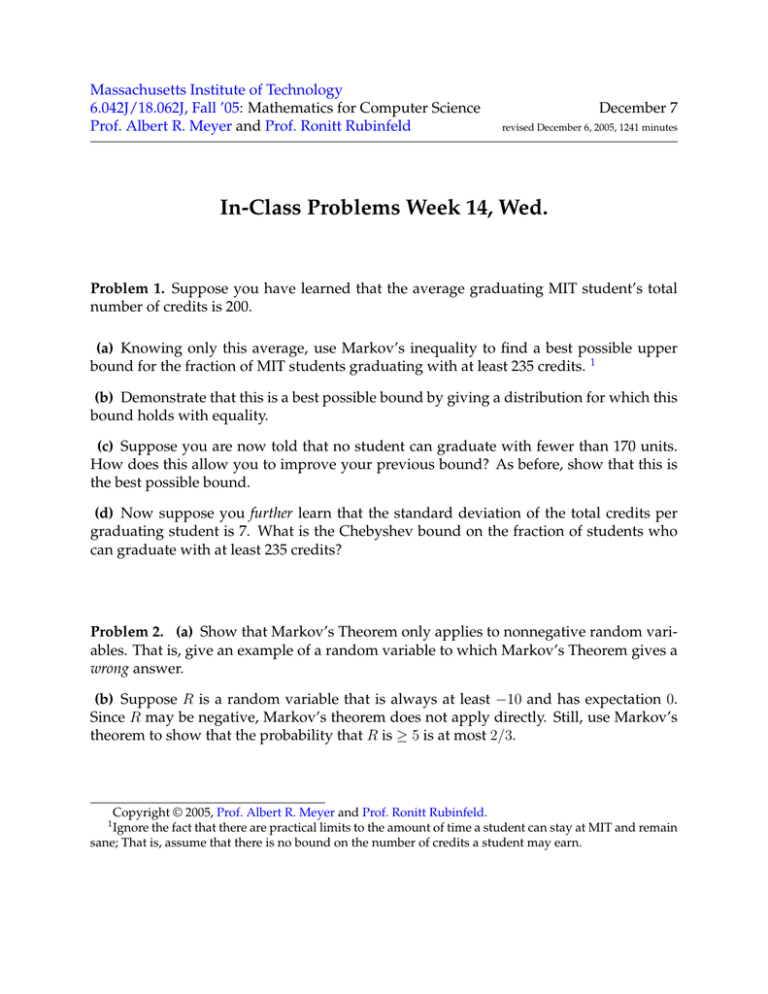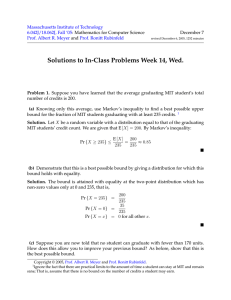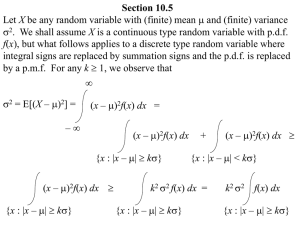Massachusetts Institute of Technology 6.042J/18.062J, Fall ’05 Prof. Albert R. Meyer
advertisement

Massachusetts Institute of Technology
6.042J/18.062J, Fall ’05: Mathematics for Computer Science
Prof. Albert R. Meyer and Prof. Ronitt Rubinfeld
December 7
revised December 6, 2005, 1241 minutes
In­Class Problems Week 14, Wed.
Problem 1. Suppose you have learned that the average graduating MIT student’s total
number of credits is 200.
(a) Knowing only this average, use Markov’s inequality to find a best possible upper
bound for the fraction of MIT students graduating with at least 235 credits. 1
(b) Demonstrate that this is a best possible bound by giving a distribution for which this
bound holds with equality.
(c) Suppose you are now told that no student can graduate with fewer than 170 units.
How does this allow you to improve your previous bound? As before, show that this is
the best possible bound.
(d) Now suppose you further learn that the standard deviation of the total credits per
graduating student is 7. What is the Chebyshev bound on the fraction of students who
can graduate with at least 235 credits?
Problem 2. (a) Show that Markov’s Theorem only applies to nonnegative random vari­
ables. That is, give an example of a random variable to which Markov’s Theorem gives a
wrong answer.
(b) Suppose R is a random variable that is always at least −10 and has expectation 0.
Since R may be negative, Markov’s theorem does not apply directly. Still, use Markov’s
theorem to show that the probability that R is ≥ 5 is at most 2/3.
Copyright © 2005, Prof. Albert R. Meyer and Prof. Ronitt Rubinfeld.
Ignore the fact that there are practical limits to the amount of time a student can stay at MIT and remain
sane; That is, assume that there is no bound on the number of credits a student may earn.
1
In­Class Problems Week 14, Wed.
2
Problem 3. There are n people at a circular table in a Chinese restaurant. On the table,
there are n different appetizers arranged on a big Lazy Susan. Each person starts munch­
ing on the appetizer directly in front of him or her. Then someone spins the Lazy Susan
so that everyone is faced with a random appetizer. In class, we saw that the expected
number of people that end up with the appetizer that they had originally is 1.
Let Xi be the indicator variable for the ith person getting their own appetizer
�nback. Let
Sn be the total number of people who get their own appetizer back, so Sn = i=1 Xi .
(a) What is E [Xi2 ]?
(b) For i �= j, what is E [Xi Xj ]?
(c) What is E [Sn2 ]?
(d) What is Var [Sn ]?
(e) Discuss the accuracy of the Chebyshev Bound on the probability that Sn is distance
x from its expectation as x ranges over integers between 1 and n.
Problem 4. For any random variable, R, with E [R] = µ and Var [R] = v, the Chebyshev
Bound says that for any real number x > 0,
v
Pr {|R − µ| ≥ x} ≤ 2 .
x
Show that for any real number, µ, and real numbers v, x > 0, there is an R for which the
Chebyshev Bound is tight, that is,
v
Pr {|R| ≥ x} = 2 .
(1)
x
Hint: Assume µ = 0 and let R be three valued with values 0, −x, and x.
Problem 5. The covariance, Cov [X, Y ], of two random variables, X and Y , is defined to
be E [XY ] − E [X] E [Y ]. Note that if two random variables are independent, then their
covariance is zero.
(a) Give an example to show that having Cov [X, Y ] = 0 does not necessarily mean that
X and Y are independent.
(b) Let X1 , . . . , Xn be random variables. Prove that
Var [X1 + · · · + Xn ] =
n
�
i=1
Var [Xi ] + 2
�
i<j
Cov [Xi , Xj ]







